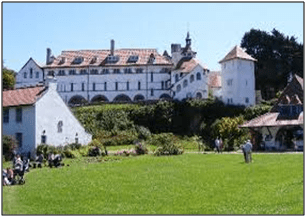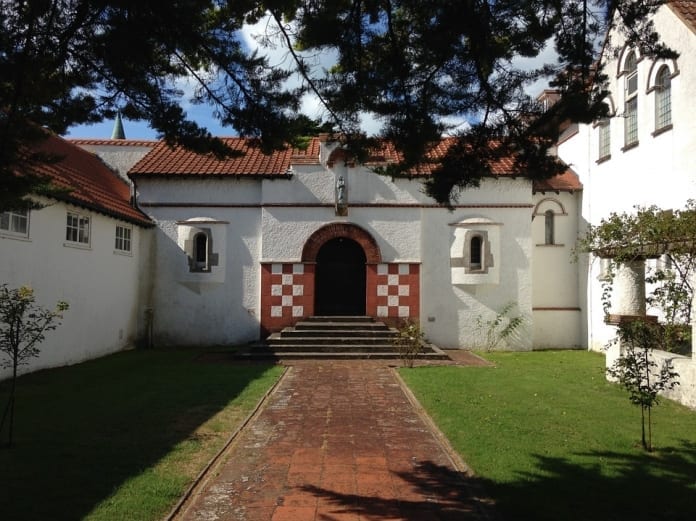For those who visit Tenby, that picturesque and most delightful of all West Wales seaside towns which sits lazily on the Pembrokeshire coast, surely the prime attraction is the wonderful scene that greets everyone who looks out to sea from South Beach and the esplanade. I am of course talking about the Holy Island of Caldey which is permanently cut off from the mainland and also, the small tidal St Margaret’s Island which sadly is closed to the public. For anyone who has not visited Caldey Island, then I urge you to take the short boat ride during the summer and pop over to this embodiment of serenity, loveliness and total charm.
 I will never forget a wonderful conversation I once had with a very elderly Benedictine monk by the name of Sam from New York, who had served with US Air Force Bomber Command during World War II and he told that one night, whilst on a bombing raid over Eartern Germany, he experienced a ‘moment of truth’ as he put it and in an instant, discovered his faith. Sitting in the tranquil St David’s Church just yards from the beautifully white-washed red terracotta tiled monastery, Sam and I chatted about his incredible life and so it was with great sadness just a couple of years later, that I learned that he had passed away.
I will never forget a wonderful conversation I once had with a very elderly Benedictine monk by the name of Sam from New York, who had served with US Air Force Bomber Command during World War II and he told that one night, whilst on a bombing raid over Eartern Germany, he experienced a ‘moment of truth’ as he put it and in an instant, discovered his faith. Sitting in the tranquil St David’s Church just yards from the beautifully white-washed red terracotta tiled monastery, Sam and I chatted about his incredible life and so it was with great sadness just a couple of years later, that I learned that he had passed away.
Caldey Island’s history is truly fascinating and it was around 8,000 BC that the sea around Britain’s coast rose with the end of the Ice Age and with it, hundreds of islands were formed including Caldey Island. Over the years, numerous archeological digs and investigations have yielded a wealth of new finds and clear evidence that show there was human life on this former penisula during both the Iron and Bronze Ages and indeed, during Roman, Anglo-Saxon and Celtic times as well. The monks on Caldey Island still carry on the one thousand year tradition of Christian worship and prayer and it was around the beginning of the 6th century that the first recorded Abbot called Pyro, led the monastic community at the original monastery of which, the ruins still stand approximately eight hundred metres south of the present day abbey and is known as the ‘Old Priory’ and close to it, is the ancient church of St Illtyd. The Welsh name for Caldey Island is ‘Ynys Bri’ and named after Abbot Pyro and the term ‘abbot’ itself, derives from the Aramaic for ‘father’ which is ‘Abba’ and this, was the language spoken by Jesus Christ.
Caldey Island is derived from the Viking word for ‘spring’ which is ‘Kelda’ and this makes sound sense, given there was a heavy Viking presence across South West Wales around the 10th century such as Swansea, which itself was named after the Norse word for ‘Sveinn’s Island’. Monastic life in the 11th century returned to the island with the occupation of Britain by the Normans around 1071 when, Benedictan monks from Tiron established themselves as a ‘cenobitic’ community. This term is the given to any religious Order that does not serve as ‘solitary hermits’ and in the case of Caldey Island, they worshiped in the original abbey mentioned above.
 Following Henry VIII’s breakaway from Papal supremacy between 1532 and 1534, the English king was pronounced ‘Supreme Head on earth of the Church of England’ and in 1533, he married his second wife namely Anne Boleyn. The admistrative and legal ‘Act of Supremacy’ passed by Parliament in 1534 is better known as the ‘Dissolution of the Monasteries’ and allowed for monasteries such as the Benedictan community of Caldey Island to be brutally disbanded during the dark period of 1536 to 1541 and with it, all wealth and assets were removed by force and surrended to the king’s treasury. There have been quite a number of private landowners on Caldey Island and cattle were farmed there up until quite recently but these were airlifted off the island and today, no farming takes place of any kind.
Following Henry VIII’s breakaway from Papal supremacy between 1532 and 1534, the English king was pronounced ‘Supreme Head on earth of the Church of England’ and in 1533, he married his second wife namely Anne Boleyn. The admistrative and legal ‘Act of Supremacy’ passed by Parliament in 1534 is better known as the ‘Dissolution of the Monasteries’ and allowed for monasteries such as the Benedictan community of Caldey Island to be brutally disbanded during the dark period of 1536 to 1541 and with it, all wealth and assets were removed by force and surrended to the king’s treasury. There have been quite a number of private landowners on Caldey Island and cattle were farmed there up until quite recently but these were airlifted off the island and today, no farming takes place of any kind.
In 1900, William Done Bushell gifted Caldey Island to an Anglican Benedictine Order led by Dom Aelred Carlyle and between 1906 and 1910 and, with the help of Lord Halifax, a new monastery was built and the small row of builders’ cottages that stand in front of the beautifful abbey today gave their name to the building which is called ‘Cottage Monastery’. In 1913, the then Anglican Order of Bendictine monks became a member of the Cathloic church and as such, the former community moved to Abbey House close to Pershore Abbey in the county of Worcestershire and in 1929, a new Trappist Order from Belgium took up residency. These have remained to this day and in 1940, the monastery was destroyed by fire and rebuilt. The administrative centre for this Order is Prinknash Abbey just oustide the city of Gloucester.
Caldey Island is famous for its wonderful products such as lavender perfume, candles, chocolate, gifts, souvenirs and many other items which can also be purchased from the shore based Abbey Shop in the town of Tenby itself. Visitors can also rent ‘Retreat Accomodation’ on the island between Easter and October by contacting the Abbey direct and one final attraction on the island has to be the majestic lighthouse which sits on the southern side and looks directly out towards Lundy Island some thirty four miles south of Tenby. In 2016, Caldey Island was subjected to a high profile abuse investigation after a fugitive sex offender, who stayed at the abbey under a pseudonym between 2004 and 2011, was identified by a member of the public and later found guilty of possession of indecent images.
Written by
Philip Thomas
Help keep news FREE for our readers
Supporting your local community newspaper/online news outlet is crucial now more than ever. If you believe in independent journalism, then consider making a valuable contribution by making a one-time or monthly donation. We operate in rural areas where providing unbiased news can be challenging. Read More About Supporting The West Wales Chronicle























